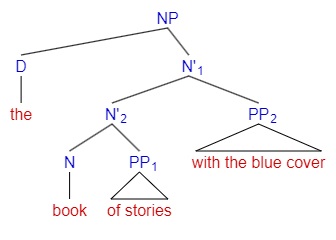Phrase-Structure Rules & X' Theory
PS-rules are the formal devices which generate constituent structure, by specifying all and only the possible ways in which categories can combine
History of Grammar
最古老的传统语法分析:Immediate Constituency Analysis 直接成分分析法。类似初等教育中语文课教的,给句子成分分主谓、述宾、述补、偏正……关系
二十世纪中期的 Formal Science 浪潮中,发生了 a cognitive revolution,诞生了 the computational theory of mind (CTM)。New concept of grammar: grammar is taken as a formal device to generate sentences,被 Chomsky 称为 Finite-State Grammar(正则表达式与有限状态机),后来这个概念被 Shannon 采用,进入信息科学
然后 Chomsky 说:Human language is not a finite-state language. Finite-State Grammar 在遇到一个 loop 时必然遗忘之前的所有 loop,而人类语言是可以产生 anti-missile missile, anti-(anti-missile missile) missile ... 这样的串的,即 \(anti^n missle^{n+1}\),需要在后一个 loop 时记得前一个 loop 循环了几轮。这些细节属于形式语言与自动机理论,不学不影响理解 syntax。
此时此刻玉泉那边,我计院的 peers 也在《计算理论》课上听这些吧?
Phrase-Structure Rules
升级改造 finite-state grammar:Phrase-Structure Rules,a kind of Generative Grammar。
Symbols:
- 每条 rule / derivation 的箭头左边是句法树里的 mother node,右边是 daughter node(s)
- non-terminal symbols: 类似 S NP VP N V 这种,出现在句法树的 non-terminal nodes 上的符号。P 是 phrase,NP、VP 等就是名词、动词的意思
- terminal symbols: 类似 Mary runs 这样具体的单词,出现在句法树的 terminal nodes 上
- VP → V (NP) (PP) 这样的 rule 中,brankets indicate optional categories,也就是说动词短语一定有动词,但可以没有宾语和介词短语
PS-rules provides 3 kinds of information:
- vertical: hierarchical structure
- horizontal: linear precedence
- categorial: the category labels of nodes in a syntax tree
出现在 PS-rules 的某一条 rule 箭头左边的符号,如果出现在另一条 rule 箭头右边,那么这组 PS-rules 可以产生循环的句子,称为 recursion。比如 the box in [the box in [the box in [the box in [the ...]]]],就是 NP 不断 derivate 出新的 NP。Recursion brings infinity to language.
Chomsky Hierarchy:当代 AI 还在 finite-state grammar 上运行。上面的 PS grammar 是一种 Context Free Grammar,比 FS / regular grammar 要复杂一个等级,而人类语言是不是 PS grammar 能描述的还有待商榷,因此目前基于 FS grammar 的人工智能只能很像地模仿人类语言,不可能完全一样
X' Theory
评价语法的标准:
- descriptive / explanatory adequacy 描写/解释充分性,可以解释一门语言的句法,和更加普遍的句法
- endocentric / exocentric 向/离心结构,也就是 XP 里有没有 X(称为 head)成分
之前学的 PS rules 是描写充分的,但不符合解释充分性的要求。它只能描述英语(language-specific),对每种成分都要编写互相无关联的规则(construction-specific),而且不能解释句法背后的心理机制。解释充分性的句法应满足:
- universal
- maximally constrained
- psychologically plausible
X' theory (read as "X-bar theory",中文叫 X 阶标理论) 是解释充分性的语法,所有语言,所有词类都有类似的规则。
最基本的句法树:\(XP→Spec\ [_{X'}X\ C]\)。
- X:中心语(head),可以是 V、N 等任意词类
- Spec:标志语(specifier / modifier),表示冠词、very 等联系相对不紧密的修饰语(adjuncts),一般省略掉也不影响句法正确与否,起到一个造型上的作用
- C:补足语(complement),是不可省略的 argument(s),应该出现的 C 省掉之后句法就不正确了,而且 typically the arguments are categorially selected (C-selected,语类选择) by the head,比如说 X 是及物动词,那么它后面跟的 complement 的词性就得是 NP
以前我们区分“adjunct”和“argument”都是凭语义,在 PS rule 中,不管是 argument 还是 adjunct 都是 head 的 sister node,由 XP 直接分化出来,体现不出 argument 在句法上比起 adjunct 跟 head 的关系更紧密(由 constituency test 确定的)。But in X-bar theory, a structural distinction between arguments and adjuncts can be properly represented. We can treat arguments as sister of X (complement), and adjuncts as sister of X' (specifier).
e.g. a book of poems,PP 是 complement;a book with blue cover,PP 是 specifier / modifier。所以判断是 specifier 还是 complement 不能只看这个 constituent 的词类,最终还是得用 constituent test 来验证到哪里算是一个 XP,其中哪些是联系更紧密的 X',哪些可以丢到 specifier 里
其实上面这个例子我上课的时候没明白为什么“of poems”不能省掉。事后想想,可能 a book of poems 里面 book 是量词,表示“一书的诗歌”而不是“一本诗歌的书”。
X' theory 有 endocentricity(向心性),every phrase should have a head;而理论上 PS rule 并没有限制 NP → V AP 这种荒谬的句法不能出现在其中,它是 exocentric 的。C-select 这种词类搭配的规则叫 categorial features,而 XP 的 categorial features 和下面的 X'、X 必须一样,这种现象叫做 the projection of categorial features。因为 projection 的存在,所以有了这些术语:XP is the maximal projection of X, X' is the intermidiate projection of X, X is the minimal projection (head) of X' and XP。
如果一个短语有多个 specifier 或多个 complement,该如何避免使用多分枝?答案是 XP 可以继续分化出 XP,X' 也可以继续分化出 X',例如:

Functional Categories: The Structure of the Clause
这一节讲的问题是,X' theory 对 NP、VP、AP、PP 显然适用,那么它是否可以解释句子和从句?
首先我们从陈述句的 NP Aux VP 结构切入,来思考“句子”到底是个什么种类的 XP。沿着这样的思路尝试应用 X' theory:
- 最原始的 PS rule:S → NP Aux VP,这不符合 X' schema
- 也许 Aux 是 specifier V',而 VP 是 V'?不对,specifier 应该是 optional 的,助动词有没有会严重影响表意;VP 的行为比起 X' 更像 XP;此外,auxiliaries carry sentential information regarding negation and interrogatives,而 Spec V' 不是句子层次的结构
- 也许可以把句子视为 AuxP,那么就可以得到符合 X' schema 的句法树 \(AuxP→NP\ [_{Aux'}Aux\ VP]\)。但是把助动词当成句子的中心成分,显然高估了其地位,因为大部分陈述句都没有助动词。每个陈述句都有的,是什么成分?
- 英语里所有句子都有时态。把 AuxP 重新解释成 TP,其中 T 表示 tense,在有 Aux 的句子中 tense 通过 Aux 表现出来,这样解释就合理多了。
因此,最终我们对陈述语序的句子的解释是:\(TP→NP[_{T'}T\ VP]\),英语里的 tense 有 past 和 non-past 两种。\([_{TP}[_{NP}he][_{T'}[_Tshould][_{VP}talk\ to\ this\ man]]]\)
对从句、疑问句的解释:它们都是补语化成分(complementizer)短语,CP → Comp TP。从句的引导词和疑问句的疑问词都是补语化成分。Comp(C)的取值可分为 ±Q,表示该引导词是否有疑问语义,比如 whether、that 分别属于 +Q 和 -Q。写成 X' theory 的形式是 \(CP→Comp\ [_{C'}C\ TP]\)。e.g.
- 从句:\(CP→Spec\ [_{C'}[_{C[-Q]}for]\ [_{TP}John\ to\ leave]].\)
- 疑问句:\(CP→[_{Spec}who][_{C'}[_{C[+Q]}did][_{TP}Mary\ t\ see\ t]]?\)
对 non-finite (infinitival) clause 的解释:T 可以取值 -T,表示没有 tense,并且导致 PRO subject,比如 \(John\ tried\ [_{S'}[_{TP}[_{NP}PRO_i][_{T'}[_{T}to][_{VP}leave]]]]\)。这里的 PRO 用来描述存在 pronoun dropping 现象的句法,表示一个空代词。下标 i 是 co-indexation 标记,表示的是 named entity(终于和 NLP 的知识串起来了!),一个句子中所有下标相同的 constituents 表示的是同一个 co-indexation。
不定式从句还可以根据 PRO subject 指代的对象分为不同的 control sentence:
- Subject control: \(John_i\ tried\ [_{S'}[_{TP}PRO_i\ to\ leave]]\)
- Object control: \(John_i\ persuaded\ Bill_j\ [_{S'}[_{TP}PRO_j\ to\ leave]]\)
- Arbitrary control: \(It\ is\ difficult\ [_{S'}[_{TP}PRO\ to\ leave]]\)
对 Gerundive clause 的解释(gerund:动名词):\(John\ dislikes\ [_{S'}[_{TP}PRO_i\ eating\ in\ public.]]\)
英语有两种从句,差别体现在句法上就是从句算 adjunct 还是 argument:
- 补足语从句 complement clause:\(NP→[_{Spec}the][_{N'}[_Nsuggestion][_{CP}that\ John\ should\ resign]]\)
- 关系从句 relative clause:\(NP→[_{Spec}the][_{N'}[_{N'}[_Nsuggestion]][_{CP}that\ John\ made]]\)